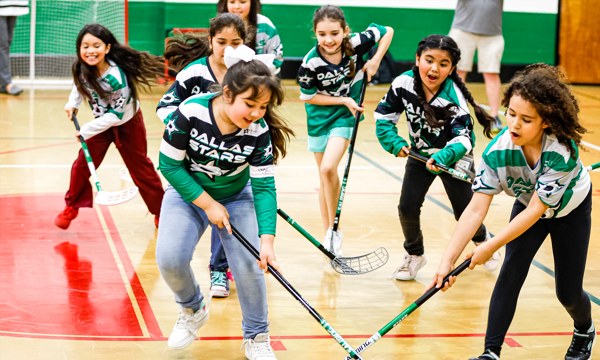The Stars aligned with his vision to make a difference and leave a legacy. Thus, he helped start the Future Stars program, in partnership with the NHL and NHLPA, which is focused on teaching and providing hockey opportunities to kids in the Dallas area.
The program’s goal is “to create sustainable hockey in underrepresented areas,” Montoya said. In the Dallas area, a key target audience is the Hispanic population; 70 percent of kids in the city’s public school system are Hispanic or Latino, Montoya said. Future Stars is an opportunity for growth and inclusion.
“It made sense to come down here and join this club to grow the game of hockey… to be that authentic representative,” said Montoya, who’s also part of the NHL Players Inclusion Coalition.
The Dallas Stars Xtreme Team, a professional instructional team made up of Stars alumni and led by Dwight Mullins, the team’s director of hockey development for the past 10 years, instructs the teachers about hockey so they can create a sustainable hockey program for the kids.
Future Stars focused on floor hockey, a more accessible option to start than trying to get everyone on the ice and learning to skate right away.
“Let the passion start there and see if they want to go to the next level,” Montoya said.
First and foremost, the instructors teach safety and how to hold a stick.
Ten-minute drills are also part of the curriculum, followed by scrimmages. Future Stars also had a tournament culminating the end of their season.
“Future Stars is just helping make sure that we have a sustainable program in place that is easy to execute and accomplishes all of the goals that we want to accomplish with the regard to participation, brand awareness, sport awareness and inclusion,” Mullins said.
The program provides equipment, like sticks and Stars jerseys, to the facilities. According to Montoya, those jerseys are a big piece for the kids to try and connect with the team, giving them a sense of belonging.
Future Stars hopes to continue growing as it enters its second season. Eventually, the next step as the program evolves is to find ways to tie in with the Learn to Play program.
“The thought was, we wanted to crawl before we ran and make sure we got these programs off right and make sure we found the right partners,” Montoya said. “And we did.”
To start, Future Stars was in eight parks and rec centers, two Boys & Girls Clubs and one school, reaching a total of just under 1,000 kids, according to Montoya. Dallas Parks and Recreation encompasses kids of all ages, though they typically have worked with students in fourth through sixth grade, Mullins said.
Exposure to the sport for kids of any age is one of the most important aspects of Future Stars. When they walk into a school or rec center to provide this knowledge and instruction, “95% of the people there have never even seen or participated in a game of hockey,” Mullins said.
“Our main goals are to expose our sport of hockey and the Dallas Stars to a base of people that really just don’t have any familiarization with it at all,” Mullins said.
This year, Montoya is hopeful to reach 16 parks and rec centers, four to six Boys & Girls Clubs and two new schools.
Even throughout the first season as word spread, they heard from more and more facilities that wanted to be part of Future Stars.
They’re biased in thinking that hockey is an awesome sport and fun to play, but Mullins said the feedback they get comes in receiving “countless inquiries” from other school districts wanting to implement this program.
“This is really a way for anybody to try to be a participant,” Mullins said.
One of the basic goals of Future Stars is to let kids know that hockey might be an option for them, whether that’s as a player, a potential career path down the line or as a Dallas Stars fan. In partnership with the parks and rec centers, the Stars supplied tickets to the centers a couple of times a month last season. Many kids attended their very first hockey game; Montoya was pleased to see kids make return trips to games as their hockey fandom grew.
“We want kids in the neighborhood or in Texas to look at that Dallas Stars logo and say, ‘That’s my logo,’” Montoya said. “It doesn’t just have to be the Dallas Cowboys. Or it doesn’t just have to be baseball. It could also be hockey.
“Providing access and opportunity is the biggest thing that Future Stars provides.”
Story from Red Line Editorial, Inc.
Hispanic Heritage Month takes place Sept. 15 to Oct. 15 every year as a time to recognize and celebrate the many contributions, diverse cultures, and extensive histories of the American Latino community. To learn more about Hispanic Heritage Month visit, https://www.hispanicheritagemonth.gov/



